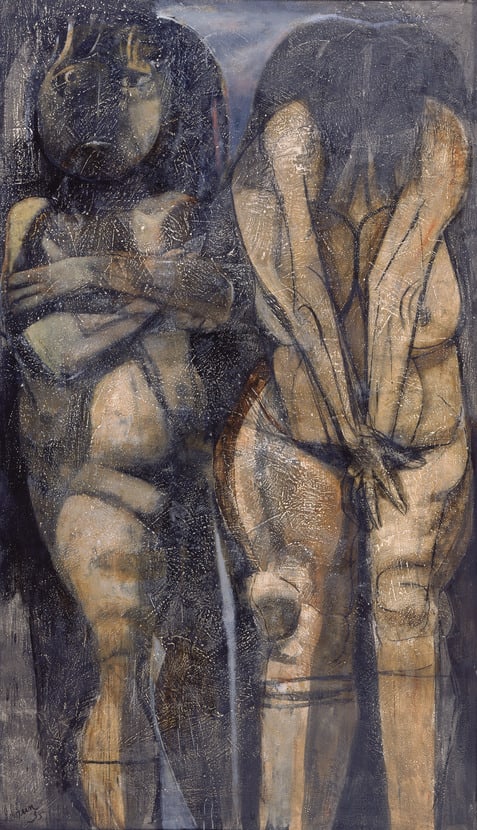
- Artist/Maker:
- Rico Lebrun
- Bio:
- American, b. Italy, 1900-1964
- Title:
- War Nudes
- Date:
- 1955
- Medium:
- Oil on masonite
- Dimensions:
- 84 × 48 in. (213.4 × 121.9 cm)
- Credit Line:
- Gift of Constance Lebrun Crown
- Accession Number:
- 1986-220
Not On View
From the first photographs of the concentration camps made available after the liberation, the inhumane devastation of the "final solution" seemed to render any rational expression impotent. The painter, Rico Lebrun decided to confront the horrors of this history:
"I wanted to remember that our image, even when disfigured by adversity, is grand in meaning; that no brutality will ever cancel that meaning: painting may increase it by changing what is disfigured into what is transfigured."
Lebrun drew inspiration for his work from four photographs published in U.S. Camera Annual 1946. Along with many drawings, the paintings were made between 1955-1959, and titled after the camps or more generally as images of war, victims, and death. The artist's approach depended upon his powers of draughtsmanship and knowledge of the human figure. Lebrun was inspired by old and modern masters, among them the trecento Pisan painter, Francesco Traini and Pablo Picasso.
Following academic studies in Naples in his native Italy, the artist emigrated to America in 1924 and settled in California in 1938. In 1959, two paintings from the several works he devoted to the victims of Buchenwald and Dachau were exhibited in "New Images of Man"--an exhibition at the Museum of Modern Art in New York that sought to challenge the dominance of abstraction in postwar American art.
"I wanted to remember that our image, even when disfigured by adversity, is grand in meaning; that no brutality will ever cancel that meaning: painting may increase it by changing what is disfigured into what is transfigured."
Lebrun drew inspiration for his work from four photographs published in U.S. Camera Annual 1946. Along with many drawings, the paintings were made between 1955-1959, and titled after the camps or more generally as images of war, victims, and death. The artist's approach depended upon his powers of draughtsmanship and knowledge of the human figure. Lebrun was inspired by old and modern masters, among them the trecento Pisan painter, Francesco Traini and Pablo Picasso.
Following academic studies in Naples in his native Italy, the artist emigrated to America in 1924 and settled in California in 1938. In 1959, two paintings from the several works he devoted to the victims of Buchenwald and Dachau were exhibited in "New Images of Man"--an exhibition at the Museum of Modern Art in New York that sought to challenge the dominance of abstraction in postwar American art.
Information may change as a result of ongoing research.